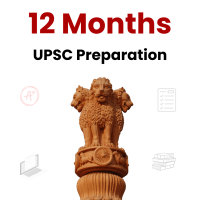UPSC Exam > UPSC Questions > Proportion of literate population in the 7 ye...
Start Learning for Free
Proportion of literate population in the 7 years and above age group is termed as
- a)Education index
- b)Mortality ratio
- c)Literacy rate
- d)Gross enrolment ratio
Correct answer is option 'C'. Can you explain this answer?
Most Upvoted Answer
Proportion of literate population in the 7 years and above age group i...
Apart from income, educational levels of the people and their health status are considered as measures to compare economic development of a nation.
(i) Infant Mortality Rate (IMR) : This indicates the number of children that die before the age of one year as a proportion of 1,000 live children born in that particular year. ‘
(ii) Literacy Rate : This measures the proportion of literate population in the 7 years and above age group.
(iii) Net Attendance Ratio : This is the total number of children of age group 6-10 attending school as a percentage of total number of children in the same age group.
(iv) Life Expectancy at birth : It denotes average expected length of life of a person at the time of birth.
(i) Infant Mortality Rate (IMR) : This indicates the number of children that die before the age of one year as a proportion of 1,000 live children born in that particular year. ‘
(ii) Literacy Rate : This measures the proportion of literate population in the 7 years and above age group.
(iii) Net Attendance Ratio : This is the total number of children of age group 6-10 attending school as a percentage of total number of children in the same age group.
(iv) Life Expectancy at birth : It denotes average expected length of life of a person at the time of birth.
Free Test
FREE
| Start Free Test |
Community Answer
Proportion of literate population in the 7 years and above age group i...
Total number of literate persons in a given age group, expressed as a percentage of the total population in that age group. The adult literacy rate measures literacy among persons aged 15 years and above, and the youth literacy rate measures literacy among persons aged 15 to 24 years.

|
Explore Courses for UPSC exam
|

|
Question Description
Proportion of literate population in the 7 years and above age group is termed asa)Education indexb)Mortality ratioc)Literacy rated)Gross enrolment ratioCorrect answer is option 'C'. Can you explain this answer? for UPSC 2025 is part of UPSC preparation. The Question and answers have been prepared according to the UPSC exam syllabus. Information about Proportion of literate population in the 7 years and above age group is termed asa)Education indexb)Mortality ratioc)Literacy rated)Gross enrolment ratioCorrect answer is option 'C'. Can you explain this answer? covers all topics & solutions for UPSC 2025 Exam. Find important definitions, questions, meanings, examples, exercises and tests below for Proportion of literate population in the 7 years and above age group is termed asa)Education indexb)Mortality ratioc)Literacy rated)Gross enrolment ratioCorrect answer is option 'C'. Can you explain this answer?.
Proportion of literate population in the 7 years and above age group is termed asa)Education indexb)Mortality ratioc)Literacy rated)Gross enrolment ratioCorrect answer is option 'C'. Can you explain this answer? for UPSC 2025 is part of UPSC preparation. The Question and answers have been prepared according to the UPSC exam syllabus. Information about Proportion of literate population in the 7 years and above age group is termed asa)Education indexb)Mortality ratioc)Literacy rated)Gross enrolment ratioCorrect answer is option 'C'. Can you explain this answer? covers all topics & solutions for UPSC 2025 Exam. Find important definitions, questions, meanings, examples, exercises and tests below for Proportion of literate population in the 7 years and above age group is termed asa)Education indexb)Mortality ratioc)Literacy rated)Gross enrolment ratioCorrect answer is option 'C'. Can you explain this answer?.
Solutions for Proportion of literate population in the 7 years and above age group is termed asa)Education indexb)Mortality ratioc)Literacy rated)Gross enrolment ratioCorrect answer is option 'C'. Can you explain this answer? in English & in Hindi are available as part of our courses for UPSC.
Download more important topics, notes, lectures and mock test series for UPSC Exam by signing up for free.
Here you can find the meaning of Proportion of literate population in the 7 years and above age group is termed asa)Education indexb)Mortality ratioc)Literacy rated)Gross enrolment ratioCorrect answer is option 'C'. Can you explain this answer? defined & explained in the simplest way possible. Besides giving the explanation of
Proportion of literate population in the 7 years and above age group is termed asa)Education indexb)Mortality ratioc)Literacy rated)Gross enrolment ratioCorrect answer is option 'C'. Can you explain this answer?, a detailed solution for Proportion of literate population in the 7 years and above age group is termed asa)Education indexb)Mortality ratioc)Literacy rated)Gross enrolment ratioCorrect answer is option 'C'. Can you explain this answer? has been provided alongside types of Proportion of literate population in the 7 years and above age group is termed asa)Education indexb)Mortality ratioc)Literacy rated)Gross enrolment ratioCorrect answer is option 'C'. Can you explain this answer? theory, EduRev gives you an
ample number of questions to practice Proportion of literate population in the 7 years and above age group is termed asa)Education indexb)Mortality ratioc)Literacy rated)Gross enrolment ratioCorrect answer is option 'C'. Can you explain this answer? tests, examples and also practice UPSC tests.

|
Explore Courses for UPSC exam
|

|
Signup for Free!
Signup to see your scores go up within 7 days! Learn & Practice with 1000+ FREE Notes, Videos & Tests.
























